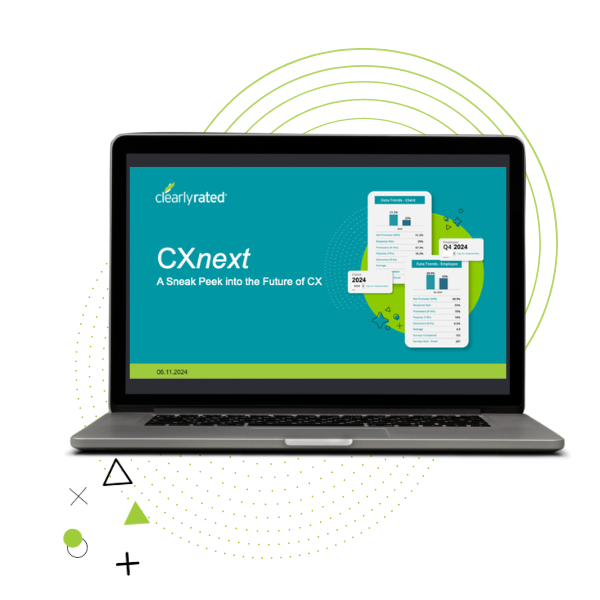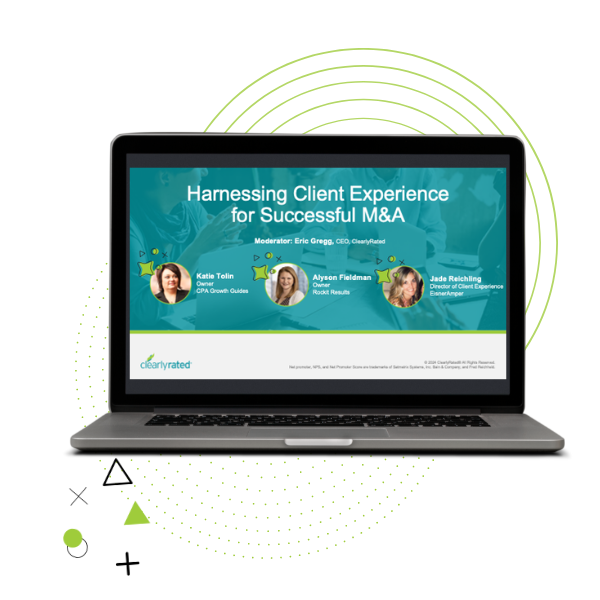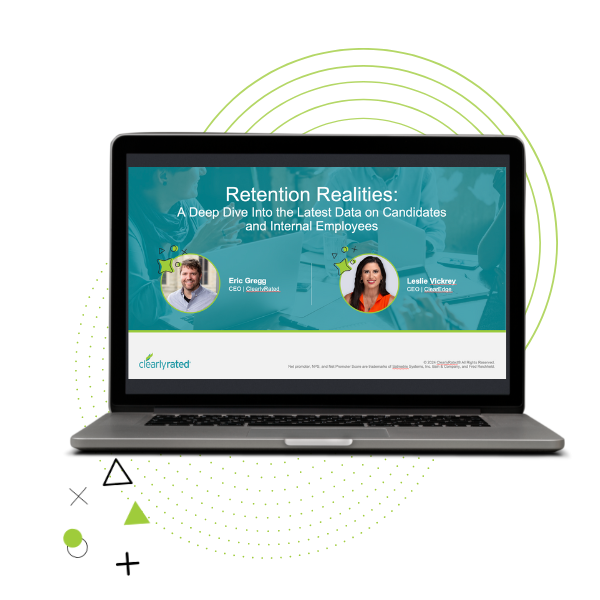Last week, Eric Gregg (CEO and Founder of ClearlyRated) hosted a panel webinar that featured three winners of the 2018 Best of Staffing® award for client satisfaction.
Susie Hall (President at Vitamin T), Tammi Heaton (COO at PrideStaff), and Jeff Miller (Managing Director at EdgeLink) are leaders of organizations with a proven track record of consistent, remarkable client service (all three organizations have won the Best of Staffing Award for 5+ years in a row!).
These powerhouse panelists took time out of their busy weeks to offer eye-opening advice on their approach to client service excellence – below are 6 key takeaways to stoke the client service fire at your firm.
Takeaway #1: Have a plan in place for executing (immediately) on survey feedback
In an industry where 90% of service providers differentiate on the service they provide, you’d be surprised to learn that more than 2 out of 5 clients who leave a staffing provider do so because of a service quality issue.
What’s more, what you do once a service issue is identified is far more indicative of your firm’s service quality than anything else.
PrideStaff, Vitamin T, and EdgeLink all execute a company-wide plan to take action within a few days of receiving a low rating from a client survey response.
- Edgelink has a policy in place to call detractors (that’s right, pick up the phone and dial to talk with a real human who is unhappy with you) within 24 hours of receiving their survey responses. With this practice at the heart of their service recovery process, Jeff stressed that these calls are “a great opportunity to thank people for taking time out of their busy days to take a survey and give their honest feedback.” What this phone call is not about? It’s not about trying to ‘fix’ the issue. Thank people for their feedback, and take action (rather than relying on words) to show what you’re going to do to fix it.
- PrideStaff has a similar approach. Any NPS® survey response that comes in with a rating of 6 or lower (i.e. any “detractor responses”) is immediately sent to a VP or strategic partner so they can follow up directly.
Don’t know what a “detractor” is or need more information on NPS®?
Check out this overview of Net Promoter® Score for staffing and recruiting firms.
Takeaway #2: Ask strategic questions, and set expectations early
Setting expectations is a foundational practice that ensures client perceptions are in-tune with the realities of delivering the service they expect from your firm.
As Susie Hall (of Vitamin T) points out, there are a variety of moments in the client relationship that warrant a pause and alignment on expectations. She gave 2 concrete examples:
- Set expectations the moment you begin a new client engagement – This is your opportunity to set expectations about what the client can expect from the talent pool based on the positions they seek to fill. Ask questions about what the client wants and if there are specific skills-based, experience-driven, or personality / culture requirements they are looking for in a candidate. Take time to document the information you gather into a target “profile” – which can serve as a helpful reminder (to your team and to the client) about communicated candidate requirements.
- Set expectations as soon as a job order has been filled – You’ve placed a qualified candidate with a client – congratulations! Take this opportunity to set expectations with the client about how your communication rhythms will evolve, when they will hear from you next, and how they will be invited to provide you with feedback. Hint: if they know that a survey is coming they’ll be more likely to complete it! This is a great opportunity to remind clients how important their satisfaction is to your firm.
Jeff Miller (of EdgeLink) used a “hunting vs. farming” analogy (yes, we’re still talking staffing firms here) to demonstrate the importance of being agile and strategic about setting expectations with individual clients based on their preferences.
For example, some clients may be aggressive and want their staffing firm to send them a large volume of candidates quickly. Other clients may be more selective when it comes to the candidates they want, so it’s important to ask strategic questions with each client to align delivery expectations with their organizational culture.
Takeaway #3: Create a culture of relationship-building
We’re in a people-to-people business, which means that building relationships is a core aspect of delivering remarkable service.
Jeff says that EdgeLink goes to great lengths to define what ‘building a relationship’ means and how it’s accomplished. The goal is to establish the practice of relationship-building into a universal vocabulary that’s embedded in the firm’s culture. ‘Building relationships’ is something to be taught, learned, and practiced – and EdgeLink does so through role-playing daily with its employees so they know how to live the principle in a variety of situations.
Take a moment to think about your firm. Do all team members understand the company’s definition of ‘building a relationship’? How long does it take a new employee to learn the concept? The sooner this understanding is embedded across employees, the sooner they’ll be able to deliver remarkable client service in the “[PrideStaff, EdgeLink, Vitamin T, etc.] way”.

Takeaway #4: Create internal excitement about client feedback
Internal recognition is essential to creating a culture that provides consistent service excellence.
- Susie at Vitamin T is copied on every single response from their NPS survey, and she reaches out personally to Superstars – team members whose clients are promoters or provide “shoutouts” in their survey feedback – to thank and congratulate them.
- PrideStaff makes a point to recognize top performers at their national conference every year as well as individual recognition in each office.
Recognizing internal staff will do more toward sustaining a culture of client service excellence than just about anything else your firm can implement. Your people enjoy knowing that they’re doing a great job – and it costs you nothing to recognize their efforts. What better way to cultivate a culture that lives, eats, and breathes service excellence?
Takeaway #5: Technology influences service quality
 It’s impossible to ignore the technological trends that underwrite our panelists’ stories of client service excellence.
It’s impossible to ignore the technological trends that underwrite our panelists’ stories of client service excellence.
Susie Hall, for example, spoke about Vitamin T’s recently launched client portal – a single location for clients to access all information gathered about a candidate including their resume, portfolio, rates and even notes from the candidate’s previous hiring manager.
Similarly, Tammi Heaton discussed how PrideStaff has made their recruiters jobs easier with a more streamlined platform. “Technology takes out the aspects of a job that are mundane and get in the way of doing business,” Tammi said. “It allows your recruiters to execute and deliver better service.”
In summary – service excellence is about people, but it’s also about setting your people up to be successful. Chances are, technology will be an essential part of the solution.
Takeaway #6: Take action on your client’s feedback
Let’s not forget the universal thread that underwrites the success of each panelist – they (1) asked their clients for feedback, (2) took that feedback seriously, and (3) took action on it.
These three crucial steps will elevate your organization above the other 90% of staffing firms who claim to “differentiate” on service. If you truly want to differentiate on service in 2018, you have to prove it.
Next Steps:
- Love what you’ve read so far and want to hear more from Susie, Jeff, and Tammi? No problem! Simply click here to watch the full webinar.
- Ready to get started with NPS? Contact the ClearlyRated team for insights, best practices, and a tour of our survey platform (designed specifically to support professional services firms).
- Considering a survey program? Our veteran team of survey experts has compiled a Satisfaction Survey Checklist for Staffing Firms to help you avoid common pitfalls and build a road map for a successful client survey initiative.
- Interested in additional data? View current NPS benchmarks for staffing firms.




